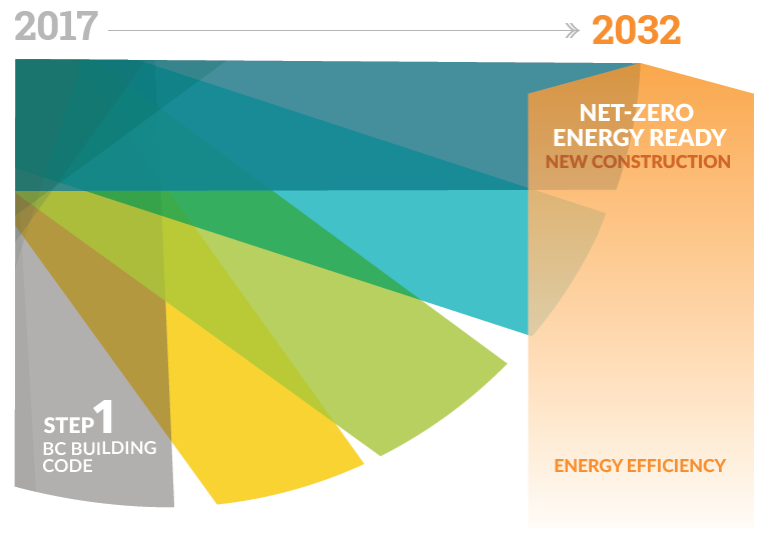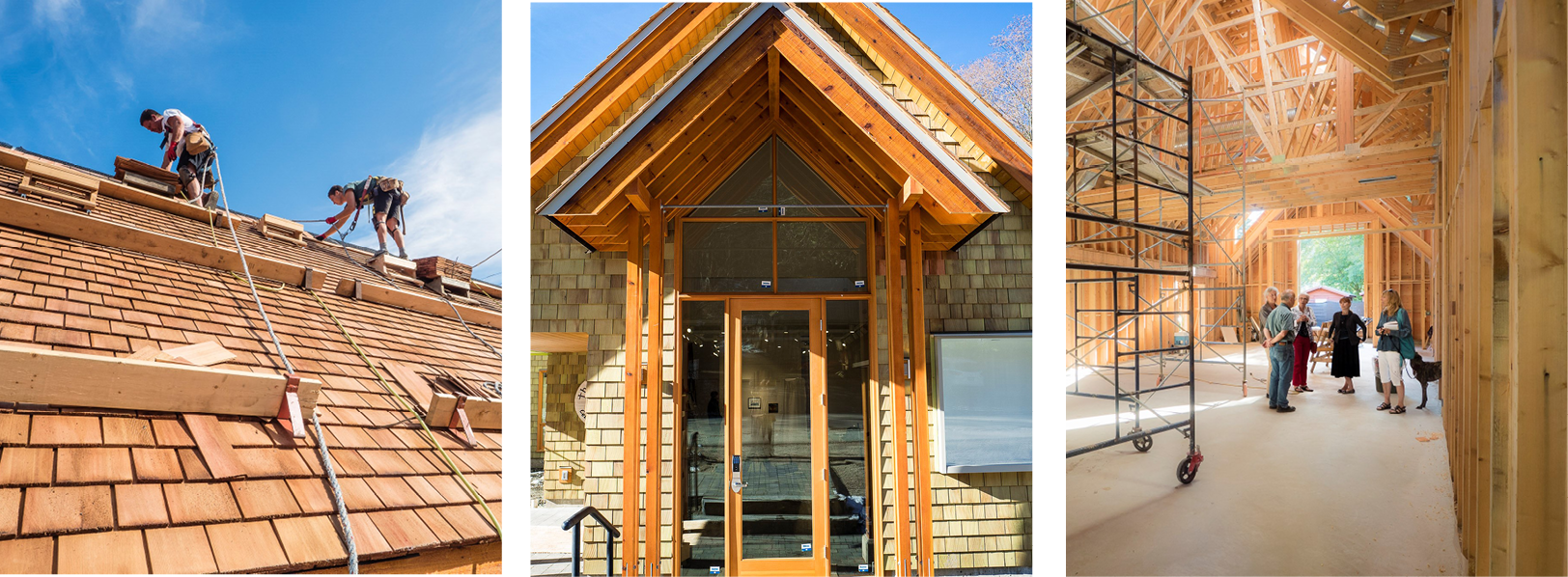BC Energy Step Code
BC Energy Step Code requirements
As of October 9, 2019, all new residential construction and substantial renovations on Bowen are required to meet Step One of the BC Energy Step Code. This requirement increased to Step 3 as of October 1, 2020.
We held a Builder’s Breakfast and Open House on September 17, 2019 to learn more about and discuss the BC Energy Step Code. You can view the slides presented by Greg Cormier, our Building Inspector, and the educational poster series here.
What does this mean?
The BC Energy Step Code is the new provincial standard to reduce building energy use and to prepare for net-zero building energy use.
Step 1 is the first step in the system. It involves modeling and testing the building’s energy use to demonstrate that the design and construction comply with current energy usage requirements of the BC Building Code.
To comply with Step 1, builders will need to create and adhere to a whole-building energy model, then test the building enclosure on the ground for air tightness. The energy model calculates how much energy the building is anticipated to use. The air tightness test measures how much air is leaking out of the building.
Step 3 is the third step in the system, and involves modeling and testing the building’s energy use to demonstrate that the design and construction go beyond BC Building Code. To comply with Step 3, builders will need to create and adhere to a whole-building energy model, then test the building enclosure on the ground for air tightness. The building’s performance will need to exceed the Building Code by 20% (or no more than 45 kWh/m2 annual energy use).
Why adopt Step Three?
By assuring building energy efficiency, we are contributing to our goal of reducing greenhouse gas emissions by 33% from 2007 by 2020. This is part of Bowen’s Climate Action Program.
By using the provincial standard, Bowen Island is joining 44 other municipalities (and growing) across the province in working towards a single, performance-based standard. By starting with Step 1, we are aiming for an easy roll-out of the program. Increasing to Step 3 will ensure that our buildings will perform more efficiently than the base requirements and help our builders be ready for future more restrictive energy codes. This approach should make it easy for everyone to make a difference.
What is the bigger picture?
The BC Energy Step Code is a provincial regulation that local governments may use, if they wish, to incentivize or require a level of energy efficiency in new construction that goes above and beyond the requirements of the BC Building Code. It consists of a series of steps, representing increasing levels of energy-efficiency performance. By gradually adopting one or more steps of the standard, local governments can increase building performance requirements in their communities. The Province of British Columbia has set a goal that all new buildings must reach a net-zero energy ready level of efficiency by 2032; the BC Energy Step Code serves as the policy pathway to reach that goal. A net-zero energy ready building is one that has been designed and built to a level of performance such that it could, with the addition of solar panels or other renewable energy technologies, meet its energy needs entirely on-site.

What are the technical requirements?
The BC Building Code 2018 (Division B, Section 10.2) requires that buildings be designed and constructed to conform to either ANSI/ASHRAE/IESNA 90.1 “Energy Standard for Buildings Except Low-Rise Residential Buildings,” the National Energy Code for Buildings (NECB), or the requirements indicated in the table below.

In addition, all buildings must conduct Energy Modelling conforming to with Part 8 of the NECB or the City of Vancouver Energy Modeling Guidelines.
Updates and amendments to the BC Energy Step Code Requirements are found here.
What about the Passive House system?
According to the BC Building Code 2018 (Division B, 10.2.3.3), buildings which conform to the Passive House Planning Package, version 9 or newer, may comply if the building is designed and constructed by a person approved by the Passive House Institute as a Certified Passive House Designer or Certified Passive House Consultant.
Where can I find a consultant for this?
An Energy Advisor is a third-party consultant that offers both energy modelling and airtightness testing. The BC Energy Code Council keeps track of several organizations who offer lists of approved energy advisors.
Where can I find out more?
Additional information can be found on the Energy Step Code Council website. The Energy Step Code Council is a cross-sector body that monitors implementation of the standard while serving as a bridge between the province, local governments, utilities, and industry. It identifies emergent impacts or issues and works to resolve them. The council also establishes best practices and makes resources available to ensure local governments employ the standard responsibly. Natural Resources Canada’s Energy Efficiency for Buildings offers information on maximizing energy efficiency, including training opportunities and energy management software.
What resources are available to help?
Bowen Island Municipality has been awarded $12,000 in rebate funds for our community from BC Hydro’s Energy Step Code Building Incentive Offer. To be eligible, the project must be a Part 9 (i.e. residential) building with a building permit application submitted on or after BC Energy Code regulations become mandatory. Rebates of up to $250 will be available for energy modeling costs and up to another $250 for the post-construction blower door test, with a maximum of $500 per project. To apply for the rebates, applicants must indicate their interest at the time of their permit application submittal. To be eligible for the energy modeling rebate, a pre-construction report must be completed by an Energy Advisor and the corresponding Step Code compliance template must be submitted with the initial building permit application. To be eligible for the post construction blower door test rebate, an Energy Advisor must complete and submit the corresponding Step Code template confirming the Step Code level achieved following project completion. Limited funds are available and so rebates cannot be guaranteed.
For renovation projects that include some energy efficiency upgrades on a residence, homeowners may be eligible for additional rebates from BC Hydro. To be eligible, renovations must be on a year-round residence connected to BC Hydro or Fortis BC with at least a year of utility billing history. Rebates up to $10,000 are available for upgrades to insulation, water heating, windows and space heating. Find out more here.
Find out about more about incentives for small businesses, commercial builders, and developers on BC Hydro’s Programs and incentives page.
The BC Energy Step Code website also maintains a list of available incentives such as from CleanBC or Better Buildings BC here.
Building a Legacy Toolkit
Building Envelope Mock-Up Assemblies: Technical Booklet:
ESC Case Study Overview:
Building A Legacy - case studies on YouTube:
- Hideaways Development Case Study
- Fort Point Residence Case Study
- Forest Crowne Case Study Part 1 of 2
- Forest Crowne Case Study Part 2 of 2
- Mark Street Townhome Case Study
Building A Legacy- case studies print:
- CaseStudies_RDEK-four.pptx
- CaseStudies_RDEK-four.pdf
- CaseStudy_ESC_Kimberley_pathway_to_success_2019.pdf
- CaseStudy_ESC_Invermere_Nov2018.pdf
For more information
If you have any questions about the BC Energy Step Code, please contact the Planning Department.
Downloads
- Bowen Island Community Energy Emissions Plan, 2016
- BC Hydro’s Energy Modelling Guideline, Jan 2019
- BC Energy Step Code Builder Guide and Design Guide
Forms
- BC Energy Step Code Compliance Report AsBuilt
- BC Energy Step Code Compliance Report PreConstruction
 Photos courtesy of Leonard Gilday.
Photos courtesy of Leonard Gilday.
Last Updated on 2022-03-31 at 8:34 AM


